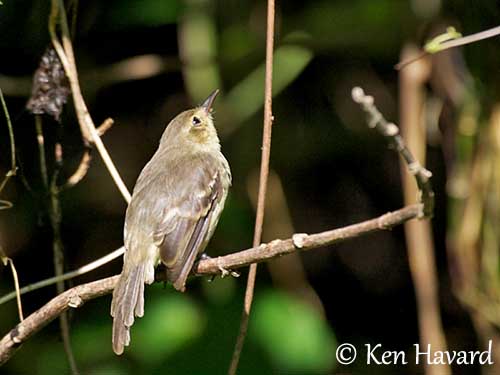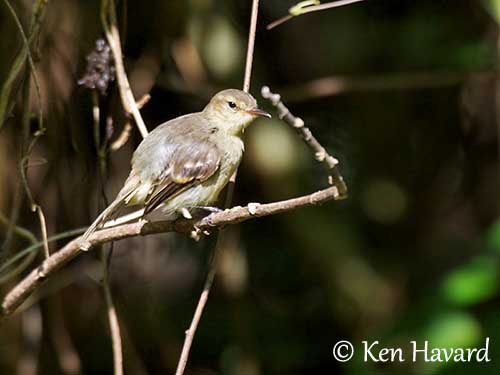
Fr: Tyranneau de Cocos
All: Cocos-Insel-Tyrann
Esp: Mosquerito del Coco
Ita: Pigliamosche dell'isola di Cocos
Nd: Cocostiran
Sd: Cocosflugsnappare
Photographer:
Ken Havard
My Bird Gallery & Flickr gallery 1 & Flickr gallery 2
Text by Nicole Bouglouan
Sources:
HANDBOOK OF THE BIRDS OF THE WORLD Vol 9 - by Josep del Hoyo - Andrew Elliot - David Christie - Lynx Edicions - ISBN: 8487334695
BirdLife International (BirdLife International)
Wikipedia, la enciclopedia libre
Cocos Flycatcher
Nesotriccus ridgwayi
Passeriformes Order – Tyrannidae Family
INTRODUCTION:
The Cocos Flycatcher is the only member of the genus Nesotriccus. It is included in the family Tyrannidae, subfamily Elaeniineae. It is endemic to Cocos Island (Costa Rica), and the unique flycatcher of the Cocos Island National Park.
DESCRIPTION OF THE BIRD:
Biometrics:
Length: 13 cm
Weight: 11 g
The adult has variable greyish-olive to dark brownish-olive upperparts and head. The wings and the graduated tail are darker. On the upperwing, we can see two dull yellowish-buff wingbars and edges of flight-feathers.
The underparts are pale yellowish to greyish-buff, with brownish to olive tinge on breast.
On the head, there is an indistinct whitish supercilium.
The long, broad, two-tone bill has brown to black upper mandible, whereas the lower one is whitish or pale horn. The bill tip is dark. The eyes are dark brown. Legs and feet are grey.
Both sexes are similar.
The juvenile has browner plumage overall, with buffy or cinnamon wingbars and supercilium.

RANGE:
The Cocos Flycatcher is found on Cocos Island, SW off Costa Rica.
HABITAT:
The Cocos Flycatcher frequents various habitats from sea-level to 575 metres of elevation, in the highest hills where it can be found in humid forest and forest edges, scrub, swampy areas and secondary growth.
CALLS AND SONGS:
The Cocos Flycatcher utters descending and accelerating trill, an explosive chatter of 6-9 syllables. It also gives a series of “tic” notes followed by another explosive trill of 7-10 syllables.
The female utters only one song type, also an explosive series of 9-10 notes followed by softer sounds.
Both mates may perform duets often initiated by the female.
BEHAVIOUR IN THE WILD:
The Cocos Flycatcher feeds primarily on various insects and spiders, but it also takes some fruits and seeds according to the season.
It usually forages well above the ground in the thick vegetation. It makes short pauses and searches for preys on leaf undersides by upwards strikes. It also hunts by aerial hawking, hover and perch-gleaning, like all flycatchers. It performs sallies from perches and pursues its prey with acrobatic flight.
Mates have long-term pair-bonds, and remain together all year round. They are monogamous, and defend the territory. During the breeding season, the male sings and performs displays.
The Cocos Flycatcher is resident within its restricted range.
It has an agile flight, hovering when hunting and pursuing its preys with fast, acrobatic flight among the dense vegetation.

REPRODUCTION OF THIS SPECIES:
The breeding season occurs between January and April/May.
Both sexes build the nest, a small cup-shaped structure placed between 10 and 25 metres above the ground in tall tree. It is made with plant fibres, and the outer part is adorned with spider oothecae (egg mass). The inner cup is lined with feathers. The nest is anchored to the vegetation near the top of a tall tree and in outer foliage, especially in Saccoglottis holdridgei, or Hibiscus tiliaceus.
The female lays a single creamy-white egg and incubates alone. But the chick is fed by both parents.
PROTECTION / MENACES / STATUS:
The Cocos Flycatcher has very restricted range where it is common. Its population is estimated at 6,000/15,000 mature individuals.
In spite of degradation of the habitat by introduced herbivores, the Cocos Flycatcher is tolerant to habitat modification and its population appears stable.
But due to its tiny range, this species is currently listed as Vulnerable.